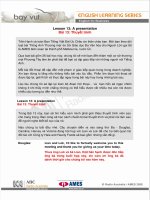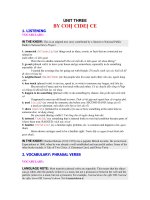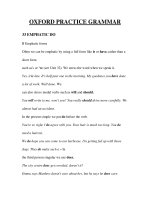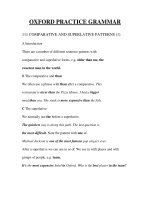Tài liệu KEY LEARNINGS: LANGUAGE ARTS pptx
Bạn đang xem bản rút gọn của tài liệu. Xem và tải ngay bản đầy đủ của tài liệu tại đây (165.11 KB, 7 trang )
8
KEY LEARNINGS: LANGUAGE ARTS 2003-2005
Receptive and Expressive Languages: Reading, Writing, Viewing, Visually Representing, Listening, and Speaking
KINDERGARTEN
Viewing
• View pictures to gain meaning
• Predict unknown words from picture clues
• Answer questions as a means to understanding content
• Share thoughts and feelings after viewing visual media
• Sequence story events using pictures
Listening
• Make eye contact
• Listen and follow one and two step directions
• Listen to others while waiting for turn to speak
• Listen to a variety of media
Reading
• Phonemic awareness
• Explicit systematic phonics
• Pre-reading concepts
• Follow print from left to right
• Make connections between words and pictures
• Know that print tells the story
Speaking
• Learn simple rules for conversation
• Share information and ideas clearly
Visually Representing
• Experiment with visual forms of communication
• Design visual media to model what makes presentations appealing
Writing
• Print from left to right
• Use invented spelling
• Correctly spell CVC/CVCC words
• Dictate or write a personal experience in sequential order
• Begin to use ending punctuation
• Begin to use capitalization
FIRST GRADE
Viewing
• Use picture clues to predict content
• Compare and contrast works read and viewed
• Understand that media messages are created by people
• Distinguish characteristics between fantasy and reality
Listening
• Listen and stay on the topic when participating in a conversation
• Listen attentively and respectfully to others while waiting for turn to speak
• Summarize auditory information
Reading
• Phonemic awareness
• Explicit systematic phonics
• Share what is read
• Recognize sight words
• Use correct clues to predict new words
9
LANGUAGE ARTS continued 2003-2005
Speaking
• Retell familiar stories
• Deliver brief recitations
Visually Representing
• Develop informational visual media
• Connect information with personal experiences
Writing
• Leave proper spacing between words and sentences
• Spell word family patterns
• Write complete sentences
• Begin the writing process
• Use ending punctuation
SECOND GRADE
Viewing
• State the main idea or message in visual media
• Explain personal thoughts and feelings after viewing media
• Use picture clues to predict content
Listening
• Use appropriate posture facing the speaker
• Provide immediate feedback
• Ask and answer relevant questions briefly and politely
• Determine purpose for listening
Reading
• Apply phonics elements in reading and writing
• Decode words in isolation and in connected text
• Know story elements
• Apply a variety of strategies to learn word meanings
• Use comprehension strategies to improve comprehension
• Increase speed of reading while maintaining accuracy
Speaking
• Convey clear and focused main idea with supporting details
• Ask questions to clarify information
Visually Representing
• Produce visual media to differentiate real and imaginary information
• Create visual media to demonstrate understanding
Writing
• Form letters and words so they can be easily read by others
• Correctly spell high-frequency sight words
• Practice the writing process
• Begin using characteristics of good writing
• Evaluate one’s own writing
• Develop paragraphs with one topic and at least four supporting details
• Write for various purposes
• Use basic rules of punctuation
THIRD GRADE
Viewing
• Analyze information learned from media
• Summarize and sequence events and ideas
• Identify the main format of visual media
10
LANGUAGE ARTS continued 2003-2005
Listening
• Listen without interrupting
• Identify how literature uses the sounds of language
Reading
• Apply phonics elements in reading and writing
• Use dictionary and glossary to learn word meanings
• Read both narrative and expositive text
• Read fiction and nonfiction
• Read aloud, speaking clearly and with expression
Speaking
• Speak clearly, using correct grammar and words
• Express ideas in a logical manner
• Use facial expressions and gestures
Visually Representing
• Develop visual media to organize and group specific information
• Create visual media to show main idea and supporting details
Writing
• Transition to cursive writing
• Practice the writing process
• Begin using characteristics of good writing
• Introduce and use parts-of-speech
• Write friendly letters
• Indent the beginning of a paragraph
• Expand the use of correct punctuation
• Proofread
FOURTH GRADE
Viewing
• View visual media for a specific learning purpose
• Ask questions for clarification of visual media
• Recognize how impressions of visual media can influence understanding
Listening
• Listen to and show respect for ideas of others
• Identify false or misleading information
• Connect learning to all subjects from what is heard
• Identify persuasive messages
Reading
• Decode unfamiliar words
• Use punctuation clues to help read aloud
• Understand author’s purpose
• Read aloud, adjust speed of reading to suit purpose and difficulty of material
• Identify figurative language
• Use word origins and derivations to understand word meanings
• Use the thesaurus to learn word meanings
Speaking
• Use notes and memory aids to assist in speaking effectively
• Convey clearly focused main idea and details, making connection and transition among ideas and
elements
Visually Representing
• Generate visual media to communicate topic, context, and purpose
• Construct visual media to demonstrate specific information
11
LANGUAGE ARTS continued 2003-2005
Writing
• Write legibly in cursive with proper size and form
• Practice the writing process
• Use characteristics of good writing
• Select an organizational structure to fit purpose
• Identify and use declarative, interrogative, imperative, and exclamatory sentences
• Write business letters, invitations, and thank-you notes
FIFTH GRADE
Viewing
• Interpret impressions from visual media that influence understanding
• Understand similarities and differences among a variety of media
• Determine correct word meaning from visual context using electronic devices
Listening
• Interpret a speakers topic, purpose, and perspective
• Use listening skills in group settings
• Take brief notes to identify main points and key information
• Draw inferences and reach conclusions
Reading
• Read independently, selecting appropriate reading strategies
• Use dictionary, glossary, thesaurus, encyclopedia, card catalog, and electronic devices
• Use abstract vocabulary to extend reading vocabulary
• Use skim for overview and scan for specific information to improve comprehension
• Use compare and contrast to improve comprehension
Speaking
• Use oral language skills in a variety of settings
• Participate in group discussions, refine and use cooperative group processes
• Identify persuasive messages
Visually Representing
• Develop visual media to model responsible decision-making skills
• Demonstrate how visual media techniques establish mood
• Develop visual media to show similarities and differences
Writing
• Practice the writing process
• Use characteristics of good writing
• Use figurative language to describe characters
SIXTH GRADE
Viewing
• Scan for a specific purpose using visual media
• Define and interpret examples of literary forms from visual media
Listening
• Adapt listening strategies to fit various situations
• Analyze presentations using established criteria
• Follow multi-step instructions
Reading
• Adapt pace and reading techniques
• Understand specific devices an author uses to accomplish purpose
• Recognize and determine meaning of non-standard usage – images, slang, dialects
• Read for comprehension and application
Speaking
• Use effective speaking skills in varied situations
12
LANGUAGE ARTS continued 2003-2005
• Use appropriate verbal and non-verbal techniques for oral presentations
Visually Representing
• Produce visual media to support an opinion
• Generate visual media to compare and contrast information
• Design visual media to conduct an interview
• Demonstrate how media effects the coverage of events or issues
Writing
• Begin word processing in all subject areas
• Practice the writing process
• Use characteristics of good writing
• Write entertaining and complete stories
• Check for effective transitions between sentences to unify ideas
• Write clear, coherent, and focused essays and reports including footnotes and italics
SEVENTH GRADE
Viewing
• Understand how the type of media affects coverage of events or issues
• Draw conclusions from details in visual media to answer specific questions
• Scan, infer, and summarize for a specific purpose using visual media
Listening
• Listen with an open mind
• Analyze the accuracy and validity of spoken information
Reading
• Increase word knowledge through vocabulary development across the curriculum
• Use reading for communication
• Consult other sources to clarify meaning
• Choose appropriate word meaning
Speaking
• Identify strategies used by speakers in oral presentations
• Ask questions to elaborate and clarify ideas
• Use correct vocabulary in speech
Visually Representing
• Develop visual media for taking, keeping, and reviewing notes
• Create visual media to clarify ideas
• Construct visual media to support a presentation
Writing
• Practice the writing process
• Use characteristics of good writing
• Write simple, compound, and complex sentences
• Vary persuasive words
• Expand uses of punctuation
• Use technical terms correctly
• Cite information in appropriate ways; e.g. footnote, bibliography, endnote
• Write essays within a given timeframe
EIGHTH GRADE
Viewing
• Locate and interpret examples of literary forms from visual media
• Define aspects of media production and distribution
• Determine the cause and effect of detailed answers to extend the understanding of visual media
• Use figurative language from visual media and answer specific questions to demonstrate
understanding
13
LANGUAGE ARTS continued 2003-2005
Listening
• Analyze presentations by purpose
• Analyze propaganda and argumentation
Reading
• Develop study skills
• Use specific strategies to understand confusing parts of text; e.g. predict, clarify, question, and
summarize
• Read for comprehension and application
Speaking
• Analyze the impact of media on consumers
• Participate in group discussions; refine and use cooperative group processes
Visually Representing
• Create visual media to support a presentation
• Model visual media techniques to show the impact on a particular audience
Writing
• Practice the writing process
• Begin using characteristics of good writing
• Continue enhancing the writing modes
• Narrow the topic to achieve an appropriate focus
• State main idea clearly in a cohesive one sentence thesis
• Write documents related to career development
14
Writing Process









